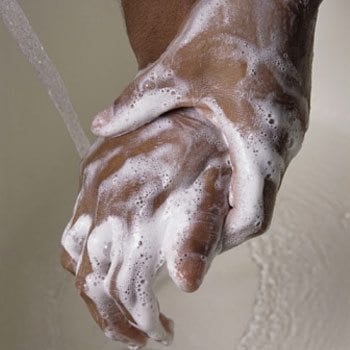
Perhaps one of the greatest success stories in public health in this country is the reduction of infectious diseases resulting from the use of vaccines. Routine immunization has eradicated smallpox worldwide and reduced some preventable infectious diseases to an all-time low. Yet this success did not come overnight. It can take 10 years or longer for the Food and Drug Administration to license a vaccine.
But there is one way to avoid or reduce the risk of several infectious diseases and it takes only 20 seconds. It doesn’t require a medical degree and anyone — including children — can master it.
It’s just plain old hand washing. Keeping hands clean is one of the best ways to prevent the spread of infection, according to the Centers for Disease Control and Prevention (CDC). Soap and water can prevent many illnesses, such as hepatitis A, influenza and the common cold that are easily spread from one person to another. It is also effective against staph infections, a leading cause of sepsis, more commonly called blood poisoning.
The problem is that not many people wash their hands correctly, if at all. Researchers from Michigan State University found that out of the 3,700 people they observed, only 5 percent washed their hands properly after using the bathroom. About one third did not use soap, and worse, 10 percent did not wash at all.
With flu season upon us, learning the correct technique of hand washing can keep you — and others — healthy. Flu viruses can live on surfaces for up to eight hours, noted the CDC. Yet, they can be destroyed by heat, soaps, alcohol and other chemicals.
The right technique
- Wet hands first with warm water
- Lather with soap for 20 seconds covering all surfaces of the hands and fingers, including between fingers and under nails
- Rinse well
- Dry hands with paper towel or air dryer
- If possible, use the paper towel to turn off the faucet
Soap and water not available?
- Use a hand sanitizer that contains at least 60 percent alcohol (isopropyl or ethyl alcohol)
- Apply to palm of one hand
- Rub hands together covering all surfaces of hands and fingers
- Continue rubbing until hands are dry
When should you wash your hands?
There’s no set number of times to hand wash each day. Certain events, however, are more likely to result in transmission of germs.
- After coughing, sneezing or blowing your nose
- After using the bathroom
- Before eating or preparing food
- After petting an animal or cleaning up animal waste
- Before and after tending to a sick person
- Before and after treating a cut or wound
- After touching any surface that could harbor flu viruses
- Whenever your hands are visibly dirty
You’re never too young to learn. Children are often more vulnerable to infectious diseases, which they can easily spread to others. Adults should supervise and help children wash correctly.






